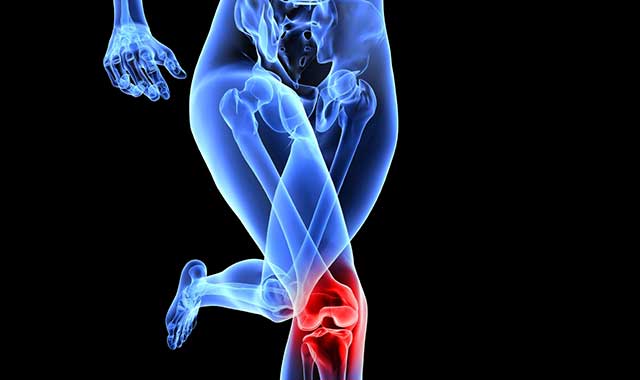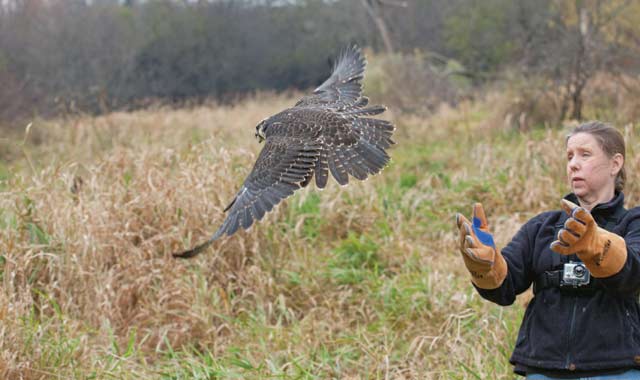Aches and pains aren’t what they used to be. Discover some of the incredible new advancements that are helping to shorten recovery times and reduce the need for invasive surgeries.

It starts as a small pain – an ache in the shoulder, a throb in the hip, a jab in the knee. It may signal injury, the onset of arthritis or plain old wear-and-tear, yet many people would rather live with the pain than see a specialist, for fear of needing complex surgery.
But aches and pains aren’t what they used to be. Thanks to incredible advances in orthopedic medicine, surgery is no longer the first, or only, option for repairing injured and worn-out joints. When it’s needed, surgery is increasingly noninvasive, allowing patients to return quickly to their active lifestyles.
One example is hip joint replacement, a procedure that’s benefitting from a significant new surgical technique called anterior hip replacement. It’s a revolutionary method adopted early on by Dr. Shawn W. Palmer, a board-certified orthopedic surgeon and fellowship-trained expert in joint replacement surgery at the Midwest Bone & Joint Institute, with locations in Algonquin, Barrington, Elgin and Geneva.
“We’re taking a totally different approach to the traditional hip replacement procedure at Presence St. Joseph Hospital,” Palmer says. “It isn’t just a change in surgical approach – it’s a change in the approach to surgery. We are dramatically shortening recovery time from months to days, minimizing blood loss and getting patients back to the lifestyle they thought was lost.”
The anterior approach involves lying patients on their backs and performing the hip replacement through a small incision, often 3 or 4 inches long, on the front of the thigh. Unlike other hip procedures, other supporting tissues are left intact and no muscles are cut, allowing for immediate stability and a faster return to activity. Palmer says that the patient position allows the use of an X-ray guidance system, so physicians can ensure a more accurate leg length and implant position, before concluding an operation.
“A special operating table is required for this procedure, and its cost is substantial,” Palmer says. “A team must be trained, and most hospitals won’t support an anterior approach hip replacement program without expert surgeons who perform a high volume of this surgery in a safe manner. Presence St. Joseph Hospital, in Elgin, is one of only a few centers in the Chicago area to make this substantial investment, for the benefit of our patients.”
As more patients demand faster recovery, more hospitals will take notice, and more surgeons will learn the technique, says Palmer.
Following the 30- to 45-minute surgery, most patients can walk with minimal assistance within a few hours, and many go home the same day. Palmer points out that, unlike traditional posterior hip joint replacement, there are no restrictions to sitting, sleeping, stair-climbing, crossing one’s legs or sleeping on one’s side. Blood loss is minimal, and transfusions are unnecessary. Patients may begin showering the day after surgery and drive within a short period of time. Many patients return to work within two weeks of surgery.
“Experience becomes the difference,” says Palmer. “I have used the anterior approach for more than a decade in other procedures, but first began using it for hip replacement in 2010. Since that time, I have completed more than 500 anterior replacements, and have become a national instructor for the technique. Surgeons come from across the country to learn how the procedure is performed. I truly believe we provide a superior patient experience, when compared to traditional surgery.”
Best of all, this procedure isn’t unique to certain patients.
“Nearly all patients who are candidates for a hip replacement may have an anterior approach procedure,” Palmer says. “There are no restrictions for age, size, activity level or gender.”
It’s especially practical for patients concerned about their independence.
“There are many patients who may benefit from a hip replacement who often choose to suffer because they’re worried about being moved into a nursing home for rehabilitation, or are concerned about how they are going to cope at home,” Palmer says. “Because the anterior method virtually eliminates restrictions and dramatically reduces recovery time, they can reclaim their active lifestyles without fear of losing their freedom.”
Replacing Other Joints
That’s good news not only for people in need of hip joint replacement, but also for those requiring joint replacements.
That includes shoulder replacement surgeries, which were relatively rare just 10 years ago, according to Dr. Craig Cummins, a board-certified orthopedic surgeon with Lake Cook Orthopedics, who operates on patients at Advocate Good Shepherd Hospital in Barrington.
“Now, they’re not only more common, but can also be performed through smaller incisions, with minimally invasive techniques,” he says. “The implants are designed to match more closely the patient’s anatomy, often can be performed without the need for bone cement, and provide excellent results for pain relief and improved function.”
Additionally, a new operation, called a reverse shoulder replacement, is a useful treatment option for patients with arthritis and irreparable rotator cuff tears.
While shoulder joint replacement is becoming more common, disorders related to the rotator cuff tendons are more prevalent, with problems ranging from tendonitis to complete rotator cuff tears.
“Rotator cuff problems affect nearly all ages,” Cummins says. “In a younger patient, shoulder problems are typically related to overuse, such as in a baseball pitcher, or to trauma and instability, or looseness in the shoulder joint. This can occur because of sports activities or work-related stress, for example in painters or carpenters. In older patients, not only can arthritis develop, but rotator cuff tears are seen more commonly.”
But the most significant advances in shoulder surgery have come through arthroscopic techniques, which use special equipment and a camera inserted through small incisions. Patients who have arthroscopic surgery, on average, have less pain and scarring, shorter recovery times and better overall results, with a significantly decreased risk of infection.
“Today, there’s very little we can’t handle surgically,” Cummins says. “But in truth, 90 percent of patients get better without surgery. It’s sad that so many people don’t visit an orthopedic specialist because they’re concerned they’ll need surgery.”
With the appropriate oral and injectable medications, with or without physical therapy, the majority of patients don’t need surgery, he says. He adds that patients should be wary of yet-unproven nonsurgical techniques. For example, he notes recent interest in the use of platelet-rich plasma (PRP), which can be used to treat orthopedic conditions, especially tendon problems.
“The initial studies were encouraging, but the jury is still out on how useful they really are,” says Cummins. “Not only do we need more data to determine PRP’s effectiveness, but because this is experimental, it isn’t generally covered by insurance.”
Knee Injuries
Regardless of age, active people are vulnerable to knee injuries and pain, and few knee injuries are as common as tears of the anterior cruciate ligament (ACL). The American Academy of Orthopedic Surgeons (AAOS) estimates that around 200,000 ACLs are injured every year, with about half requiring reconstruction. It’s an injury most commonly seen in people who enjoy high-risk sports such as basketball, football, skiing and soccer, and often occurs when deceleration is coupled with cutting, pivoting or sidestepping maneuvers, awkward landings, or out-of-control play.
Dr. Richard Mannion, FACS, a board-certified orthopedic surgeon practicing at Northwest Community Hospital in Arlington Heights, understands the challenges of returning to actvity after an ACL injury. The higher the competition level, the longer it takes for an athlete to return to prior levels of performance. For example, with a professional athlete, he says, it’s not unusual to miss the rest of a season because of an injury that requires ACL reconstruction.
“Derrick Rose took nearly one-and-a-half years off from playing with the Chicago Bulls,” Mannion says. “However, the average, everyday athlete should recover most activities of daily life in about three months. My daughter suffered an ACL injury in high school varsity gymnastics. After reconstruction, she returned to playing competitive sports one year after surgery. However, she returned to all normal activities in approximately three months.”
Surprisingly, women are more prone to ACL injuries than men, in some sports, Mannion says. According to AAOS studies, this might be due to gender differences in physical conditioning, muscular strength and neuromuscular control. Other potential causes include pelvis and lower extremity (leg) alignment, increased ligamentous laxity (loose ligaments), and the effects of estrogen on ligament properties.
Following an ACL injury, patients often have a large amount of knee swelling, a loss of full range of motion, pain or tenderness along the joint line, and discomfort while walking. Mannion emphasizes that if an athlete suspects an ACL injury, it’s essential to be evaluated by a board-certified orthopedic surgeon as soon as possible. The potential consequences of a serious, untreated ACL injury vary from patient to patient, and largely depend on the patient’s activity level, degree of injury and instability symptoms.
“ACL injuries need to be treated to restore patients to their previous active lifestyle, and to prevent instability and degenerative arthritis,” Mannion explains. “Also, treating it promptly and completely now may help patients to avoid total knee joint replacement in the future.”
In the event that surgery isn’t the best option, treatment may include progressive physical therapy and rehabilitation designed to restore the knee to a condition close to its pre-injury state. Patients are educated on preventing instability, which may require the use of a hinged knee brace.
“Because there are several options involving ACL surgeries, it’s up to the patient and surgeon to discuss risks versus benefits of surgical or nonsurgical treatment, and choose the best option for that individual,” Mannion says. “A lot depends on the patient’s age, activity level and expectations for future athletic activity. ACL surgeries are complicated. I recommend that patients seek a second opinion before deciding on the treatment course that is best suited for them, and their future expectations.”
Young Athletes and Sports Injuries
Americans love sports, not only as spectators, but also as participants, whether their activity is part of a wellness routine or a rough-and-tumble game of backyard football. No matter the level of activity, injuries are still possible.
Dr. Joshua Alpert, a board-certified orthopedic surgeon with the Midwest Bone & Joint Institute who practices at Sherman Hospital in Elgin, says that 75 percent of his patients visit because of sports-related injuries.
“I’ve seen patients as young as 8 years old with ACL tears in their knees,” says Alpert, who was fellowship trained in sports medicine at Harvard University. “These cases are much more complicated than they are in adults, because these children are still growing.”
In instances of ACL tears in children under 10, Alpert says he generally recommends physical therapy to help strengthen the muscles around the knee, as well as a knee brace to help with stability. These patients are then monitored and advised not to participate in active sports until they are old enough to safely consider ACL surgery.
When performing standard ACL surgical reconstruction, it is necessary to drill through the bone, Alpert says. In children with significant growth remaining, this would mean drilling through the growth plate, which can lead to future problems.
“There are a few special techniques in which drilling can be performed while avoiding the growth plate,” Alpert says. “In some instances, the reconstruction of the new ACL may need to be placed in a different position than it is normally found. The main risk of performing surgery in this manner is a re-tear at a later age. After about the age of 15, adolescents are usually treated in the same way as adults.”
But knees aren’t the only joints that can be injured during sports or other activities. Alpert says that, although elbow injuries are relatively rare, he does see young patients who have broken their elbows in contact sports or falls. Injuries are usually treated with a short-term cast, followed by bracing, and a course of physical therapy.
“Many young people are participating in high-level throwing sports at a young age,” Alpert says. “This can commonly lead to elbow pain due to overuse. Often this is the result of throwing too many pitches or not taking enough time off between days of throwing. This can lead to elbow pain and soreness, and with severe injuries, cause a tear to one of the ligaments in the inside of the elbow, commonly called the ‘Tommy John Ligament.’”
Ankles and feet are also at risk during sports activities. Ankle sprains are fairly common, resulting in pain, swelling and difficulty in bearing weight. After the ankle is X-rayed to ensure there are no broken bones, patients are treated with a support brace and physical therapy. Alpert says it takes three to six weeks for an ankle sprain to heal, depending on the severity.
“I also see patients in their 20s and 30s who have Achilles tendon injuries,” Alpert adds. “They may be running and suddenly feel as if someone has kicked them in the heel. They hear a little pop with pain in the back of the ankle.”
Another fairly common sports-related foot injury involves the pinkie bone in the foot, or the fifth metatarsal, which can break when the foot lands too hard or unevenly.
“This bone usually breaks at the base of the bone, closer to the heel,” Alpert says. “That area of the foot has a very poor blood supply, making it more prone to breaking. The patient usually is treated in a boot, while the bone heels, for four to six weeks. For young athletes who plan to play basketball or volleyball, we can surgically repair the bone with screws, in order to enhance the chances of it healing and return them to their high-level sport.”
No one wants to face a lifetime of pain, or dread an intensive surgery to fix an injury. Thanks to steady breakthroughs in surgical and nonsurgical treatments, young athletes are getting back to their favorite sports, while older adults are retaining their active lifestyles, and living longer than ever before.



















































